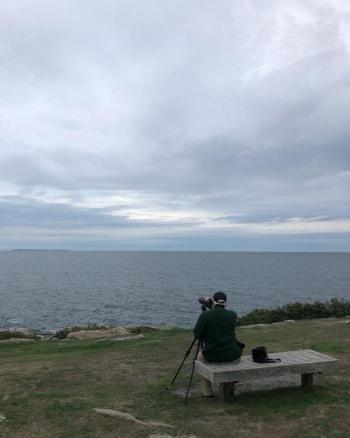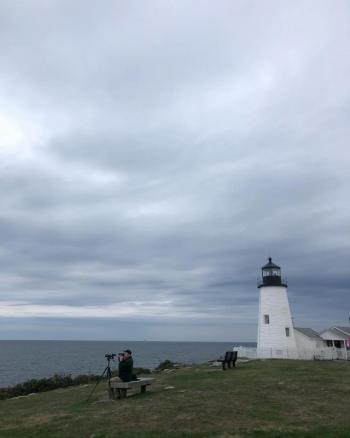Autumn Birding on a Maine Peninsula
_-_Cape_St._Mary's_Ecological_Reserve,_Newfoundland_2019-08-10_(14).jpg)
One of the unusual geological features that make Maine special are the long, stony finger-like peninsulas that extend outward into the cool waters of the Gulf of Maine. From the tips of these points—places with names like Land’s End, Cape Newagen, Ocean Point, and Pemaquid Point—people are drawn to gaze out to sea, mesmerized by some inner tug that may be different for each person.
For the birder, these spots allow us to look out on expanses of sea that are the homes for many birds found nowhere else. And to be able to watch these birds from the relative comfort and stability of land rather than the pitching deck of a boat.
On one recent startling blue-sky autumn day, drawn by the pull of the sea and smell the salty air, we were among the throngs of sea watchers who found our way to the end of one of Maine’s well-known peninsulas, Pemaquid Point. Being there, one need not wonder why it’s one of the country’s most photographed lighthouses.
As expected, the parking lot was filled with cars. Some came from across the nation but a good number were, like us, people from right here in Maine who just wanted to quietly soak up the sun and bask in the glorious beauty of our coast.
We found an open bench, set up the telescope and scanned the waters with our binoculars.
We won’t lie—we didn’t only look at birds.
It’s always irresistible to zoom in on Monhegan Island (on days when it’s not too hazy). At a distance of 10 miles away, it’s too far to see details but we love to check off the familiar landmarks—the Island Inn, the lighthouse, any number of familiar houses--from our many visits there and dream of the next visit.
Occasionally, the people taking photos of the lighthouse asked us what we were seeing. On this visit, a couple from Pennsylvania inquired. When we started talking about the huge, big-billed northern gannets we were watching diving straight down into the water from a hundred feet into the air, we discovered that they actually were also interested in birds.
We told them about the three tiny green-winged teal—ducks typically found on freshwater—we had found unexpectedly sitting amid the usual flock of much larger common eiders that frequent the point there. Our newfound friends were used to seeing green-winged teal back in Pennsylvania, but the eiders were more exciting for them since that’s a species that rarely strays from saltwater.
Our Pennsylvania friends moved on but we kept watching. Soon a line of jet black, bright orange-billed black scoters came winging by, just over the water. Later, farther offshore, a larger group of white-winged scoters zipped by, heading south as well. Both species nest far to the North in the lakes and ponds across the northern boreal forest region of Canada but winter along the Atlantic and Pacific coasts of southern Canada and the U.S.
Soon it was time for us to move on but we left fulfilled—birds, new acquaintances, and that hard-to-describe feeling that comes from quietly soaking up the beauty of an autumn day on the Maine coast.
Jeffrey V. Wells, Ph.D., is a Fellow of the Cornell Lab of Ornithology and Vice President of Boreal Conservation for National Audubon. Dr. Wells is one of the nation's leading bird experts and conservation biologists and author of the “Birder’s Conservation Handbook.” His grandfather, the late John Chase, was a columnist for the Boothbay Register for many years. Allison Childs Wells, formerly of the Cornell Lab of Ornithology, is a senior director at the Natural Resources Council of Maine, a nonprofit membership organization working statewide to protect the nature of Maine. Both are widely published natural history writers and are the authors of the popular books, “Maine’s Favorite Birds” (Tilbury House) and “Birds of Aruba, Bonaire, and Curaçao: A Site and Field Guide,” (Cornell University Press).

































